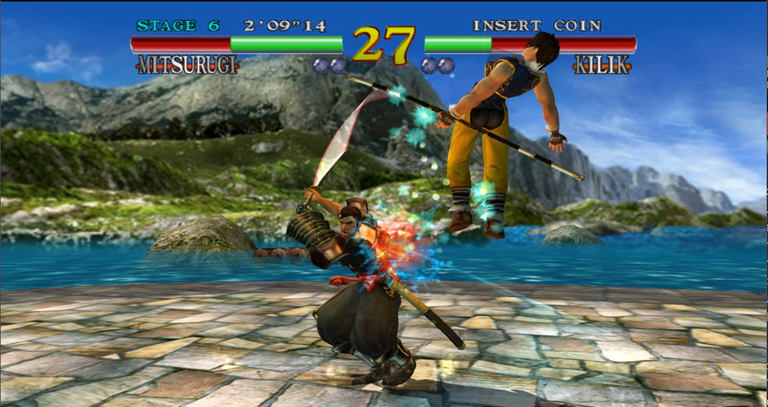

Soul Calibur on the Dreamcast was quite meaningful for a lot of reasons for the franchise. While no, this is actually NOT the first game of the series (this being Soul Edge for the PS1), it practically solidified its gameplay to what would be followed in every other game, just like how Tekken 3 set a turning point in gameplay after Tekken 2 and every game after would build on that foundation. And in the same way as T3, Soul Calibur has a brief jump in time from the events of the first game, as Mitsurugi isn't as young as before and Siegfried had turned into Nightmare due to the Soul Edge (but his previous form can be unlocked), but pretty much every Soul Edge character (except Li Long, which is replaced by Maxi) returned along with many new challengers, even including an ancestor of Yoshimitsu from Tekken!
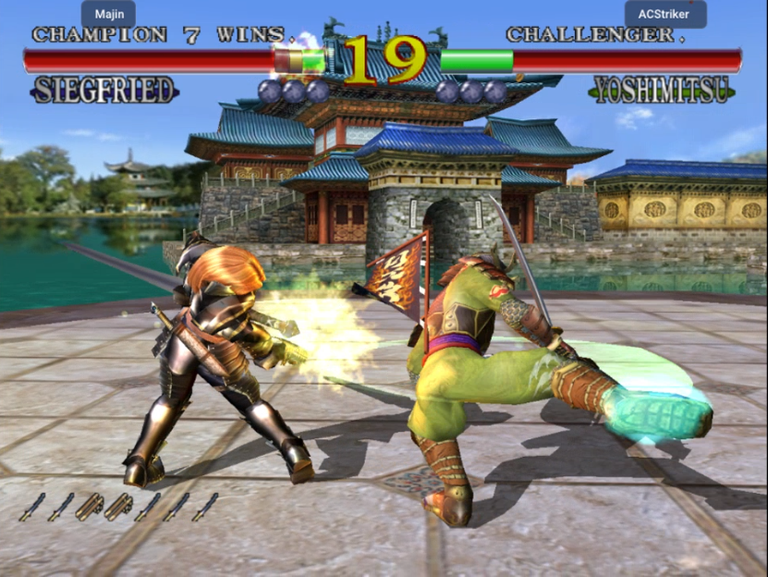
While Soul Calibur on the Arcades used the same hardware from Tekken 3 and Tekken Tag Arcade that was a slightly more powerful PS1, both Soul Calibur and Tekken Tag had a massive facelift on their respective home ports, and as Soul Calibur's released one year before Tag's and the PS2's release, Namco used all the horsepower handed down by the Dreamcast to make Soul Calibur look absolutely amazing with a high resolution display, detailed character and stage models, and more effects, all presented at a rock-solid 60fps. Paired with higher quality voice effects, sounds and music from using a disc-based storage for the game, it made an incredible difference from how their past fighting games looked like, and showcased what the back then new generation of consoles was truly capable of.

But as you probably should know, while a good presentation helps a lot, the gameplay is also pretty important...and this being Namco in the 90s, they nailed what they wanted to do with this sequel. As Tekken 3 had introduced sidestepping in and out of the background, Soul Calibur also added a 3D movement option to the franchise called the "8-Way Run", which can be activated with a backdash or sidestep but you can actually keep moving around in 8 directions. You have two weapon attack buttons, a kick button and a guard button, and swinging your attacks feels really smooth and satisfying.
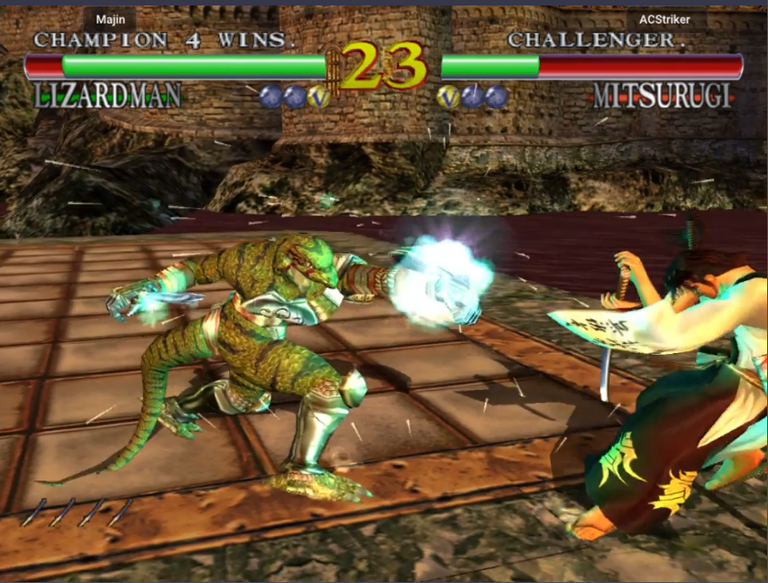
Most of the screenshots I've used here were from a couple of times where I played Soul Calibur online through an emulator, which showed me how much fun the game could be, as you have to move around carefully to avoid the range of your opponent's weapons (or block their attacks) and strike back, while you either use or avoid the edges of the stage, as anyone getting knocked off the stage is a Ring Out (and here, no stages have any sort of walls). Along with the hectic nature of a back-and-forth of clashing swords with high damage, as well as using throws or attacks made to push you off, Soul Calibur is a pretty crazy fun game to play with others!
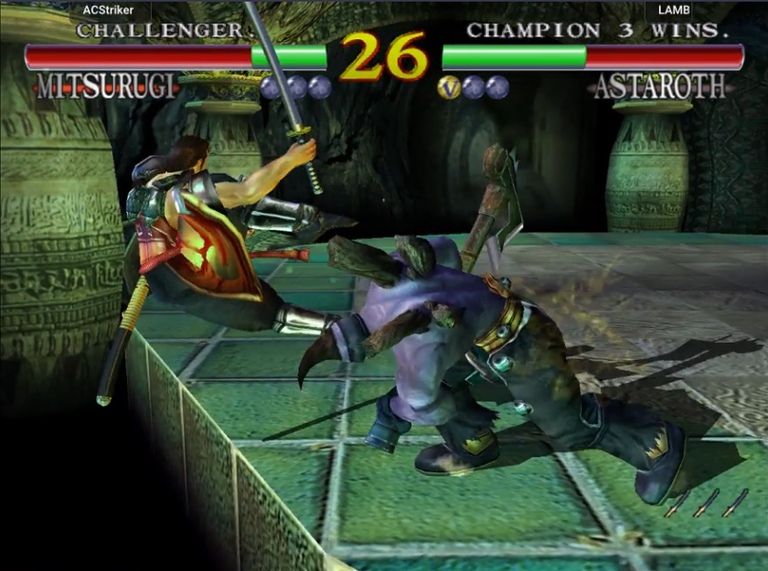
It also packs quite a lot for single player, not only having the usual Arcade, Time Attack, Team Battle and Survival modes, but also having a sort of quest mode where you pick a character, traverse around the world through a map, and fight with various enemies to unlock a variety of weapons for your preferred character, along with getting money to purchase character renders and concept art. For its time, and somehow even compared to some few modern fighting games, this game really packs a lot to dig through, let it be as a solitary warrior looking for the Soul Edge and fighting the monster inside it, or having duels with your buddies. Truly a fighting game classic of souls and swords, eternally retold...
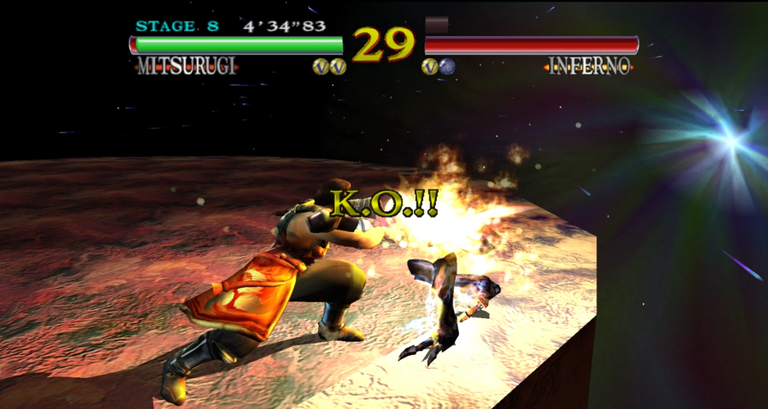
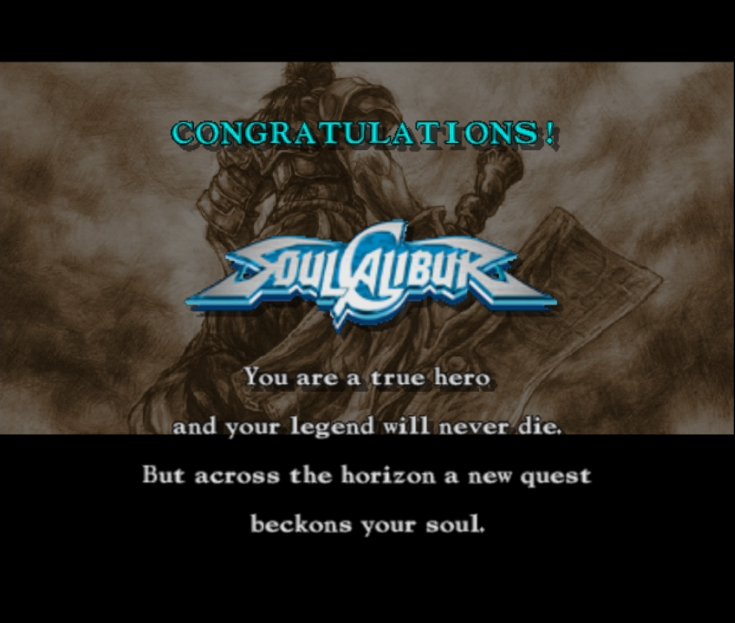

Spanish translation with DeepL. All screenshots were captured by myself.
Español
Soul Calibur en la Dreamcast fue bastante significativo por muchas razones para la franquicia. Aunque no es el primer juego de la serie (ya que se trata de Soul Edge para PS1), prácticamente solidificó su modo de juego para lo que seguiría en todos los demás juegos, al igual que Tekken 3 marcó un punto de inflexión en el modo de juego después de Tekken 2 y todos los juegos posteriores se basaron en esa base. Y al igual que en T3, Soul Calibur tiene un breve salto en el tiempo desde los acontecimientos del primer juego, ya que Mitsurugi no es tan joven como antes y Siegfried se ha convertido en Nightmare debido al Soul Edge (pero su forma anterior puede ser desbloqueada), pero prácticamente todos los personajes del Soul Edge (excepto Li Long, que es sustituido por Maxi) regresaron junto con muchos nuevos retadores, ¡incluyendo incluso un antepasado de Yoshimitsu de Tekken!

Mientras que Soul Calibur en los Arcades utilizó el mismo hardware de Tekken 3 y Tekken Tag Arcade, que era una PS1 ligeramente más potente, tanto Soul Calibur como Tekken Tag sufrieron un enorme lavado de cara en sus respectivas versiones domésticas, y como Soul Calibur salió a la venta un año antes que Tag y la PS2, Namco utilizó toda la potencia que le proporcionó la Dreamcast para hacer que Soul Calibur tuviera un aspecto absolutamente increíble, con una pantalla de alta resolución, modelos detallados de personajes y escenarios, y más efectos, todo ello presentado a unos sólidos 60 fps. Junto con los efectos de voz, los sonidos y la música de mayor calidad al utilizar un almacenamiento en disco para el juego, supuso una diferencia increíble con respecto al aspecto de sus anteriores juegos de lucha, y demostró de lo que era capaz la entonces nueva generación de consolas.

Pero, como probablemente deberías saber, aunque una buena presentación ayuda mucho, la jugabilidad también es muy importante... y siendo Namco en los 90, dieron en el clavo con lo que querían hacer con esta secuela. Al igual que Tekken 3 había introducido el desplazamiento lateral en el fondo, Soul Calibur también añadió a la franquicia una opción de movimiento en 3D llamada "8-Way Run", que puede activarse con un backdash o un paso lateral, pero en realidad puedes seguir moviéndote en 8 direcciones. Tienes dos botones de ataque con armas, un botón de patada y un botón de guardia, y balancear tus ataques se siente realmente suave y satisfactorio.

La mayoría de las capturas de pantalla que he utilizado aquí proceden de un par de veces en las que jugué a Soul Calibur online a través de un emulador, lo que me demostró lo divertido que puede ser el juego, ya que tienes que moverte con cuidado para evitar el alcance de las armas de tu oponente (o bloquear sus ataques) y devolver el golpe, mientras utilizas o evitas los bordes del escenario, ya que cualquiera que sea derribado del escenario es un Ring Out (y aquí, ningún escenario tiene ningún tipo de paredes). Junto con la naturaleza agitada de un vaivén de espadas que chocan con gran daño, así como el uso de lanzamientos o ataques hechos para empujarte, ¡Soul Calibur es un juego bastante divertido para jugar con otros!

También tiene mucho que ofrecer para un solo jugador, ya que no sólo cuenta con los habituales modos Arcade, Time Attack, Team Battle y Survival, sino que también tiene una especie de modo de búsqueda en el que eliges un personaje, recorres el mundo a través de un mapa y luchas con varios enemigos para desbloquear una variedad de armas para tu personaje preferido, además de conseguir dinero para comprar renders de personajes y arte conceptual. Para su época, y de alguna manera incluso comparado con algunos juegos de lucha modernos, este juego realmente tiene mucho que investigar, ya sea como guerrero solitario buscando hacerse con la Soul Edge y enfrentándose contra el monstruo dentro de el, o teniendo duelos con tus amigos. Un verdadero clásico de los juegos de lucha de almas y espadas, eternamente recontado...



Traducción al español hecha con DeepL. Todas las fotos capturadas por mí.